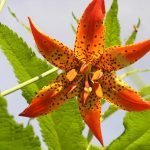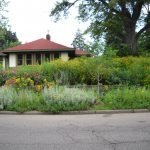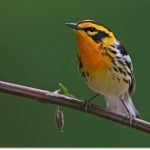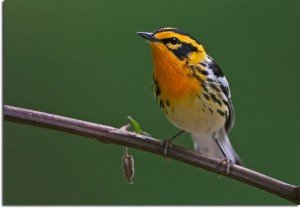In an earlier article Going Native: Even Small Amounts Bring Benefits I gave Susan Damon’s yard in St. Paul, Minnesota as an example. Recently I asked her more questions and wanted to share what she and her husband Paul have experienced with their landscaping, along with some photos.
(These are Susan’s words, I have bolded some key phrases.)
See my next post for Susan’s favorites, more photos also available in Star Tribune article about their yard
Q) What was your motivation to plant natives. Out here in SoCal water issues are a major reason – what were your reasons?
- We wanted to attract songbirds and butterflies to our yard and selected native forbs, grasses, shrubs and trees specifically known to provide seeds and berries for birds or nectar for butterflies. We also selected many plants that are hosts for butterfly larvae.
- Our primary motivation was to benefit the environment. We have a large urban corner lot that took about 45 minutes to mow with a power mower. It seemed both morally wrong and pointless to have emissions spewing from a mower just to maintain a completely unnatural lawn.
- Creating beauty is a big motivating force in our lives. We wanted to create a beautiful space that would compliment the design of our 1924 prairie-style bungalow. My husband is an artist (www.pauldamonlandscapes.com) with a M.A. in landscape architecture and I am an artist by avocation.
Q) When did you do this? (Susan’s is a good example of doing it in small pieces)
- We started in 1993 by planting a small patch of natives south of our house. Every year we expanded the patch in length and width. In 1999 we took out half of our front lawn and replaced it with natives and took out the other half the following year.
- In 2001, we removed most of the lawn on the north side of the house and planted natives, all selected to attract birds and butterflies.
- In 2003, we removed a large buckthorn (non-native, highly invasive shrub) hedge and the following year we started replacing it with native trees and shrubs.
- Between 2004-2008, we removed the sod on the front boulevard and planted natives (both transplants, mainly from our other gardens and prairie onion seeds)
Q) Can you give me some benefits it has brought, and which of those surprised you the most (or more than you expected…?)
- The garden is amazingly alive with bees and other pollinators and insects. We have seen species that we had never seen before right in our urban yard.
- When we designed the garden with birds in mind, we were mainly thinking about seeds, fruit and nuts (hazelnuts) as food sources. However, because the native plants attract so many [butterflies] lepidoptera, it has attracted large numbers of birds that feed on them including many species of warblers(e.g., yellow warblers, common yellowthroats and even a blackburnian warbler).

Blackburnian Warbler, forest species attracted to Damon’s urban yard This was perhaps the biggest suprise benefit (except for maybe the wild turkeys that wandered into the garden on a couple of occasions)! When I read Douglas Tallamy’s book, Bringing Nature Home, which focuses on the role of [butterflies] in the ecosystem and the need for native plants to sustain them, it confirmed what I had observed in my own garden.
- We have discovered that art and gardens are a great combo, and we have had a successful annual Art Sale and Garden Tour every summer since 2008.
- We have been able to give away literally thousands of seedlings, divisions and native plant seeds so that others can share in the abundance of our garden and create native plant gardens of their own.





Great article – looking forward to some photos for more inspiration!
Just posted a few photos from Susan, and you can go to the magazine articles about it for more. thx! Linda